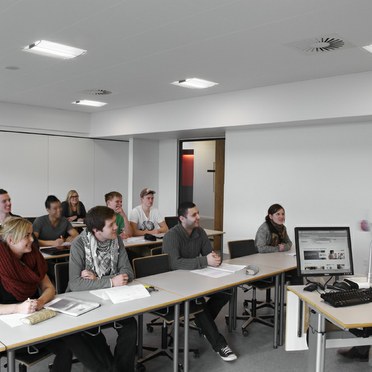Århus Akademi, Denmark
- Lamp efficacy
Lamp efficacy
Ensuring the lamp efficiently converts electricity into light (lm/W).
- Ballast classification
Ballast classification
Controlling the electricity supply to the lamp (Energy Efficiency Index).
- Luminaire distribution
Luminaire distribution
Controlling light emission using optics which bend and shape the light to the correct location.
- System efficacy
System efficacy
Combining optical and thermal control within the luminaire (luminaire lm/W).
- Presence/absence detection
Presence/absence detection
Providing lighting only when it’s needed.
- Daylight detection
Daylight detection
Reducing waste light during daylight hours.
- Constant illuminance
Constant illuminance
Producing the correct lighting levels for the duration of the maintenance period.
- Task-scene setting
Task-scene setting
Allowing the user to set scenes and adapt the lighting to different tasks.
- Timed off
Timed off
Automatic cut-off to turn all lights off during unoccupied hours.
- Task lighting
Task lighting
Lighting task areas with the correct amount of light.
- Zoning of lighting
Zoning of lighting
Zoning lighting in accordance to occupancy patterns or window location.
- Maintenance schedule
Maintenance schedule
Tailoring maintenance schedules in accordance to product age, performance and environment.
- Waste light
Waste light
Eliminating waste light which does not hit the intended target.
- Reflectance
Reflectance
Taking advantage of light which is reflected from the surface within the space.
- Visible smart metering
Visible smart metering
Enabling results of actions to be quickly seen as increased or decreased energy use to encourage responsible energy consumption.
Zero-energy school building uses Menlo3
When Århus Akademi refurbished the old classrooms and expanded the school they chose Menlo3. With an LOR that exceeds 80%, the lux level is 30% higher compared with the old installation. Combined with a lower wattage and lighting controls the result is up to 70% lighting energy savings.
Energy savings were of great importance for the new facilities because it is classified as a zero-energy building. The lighting is equipped with daylight controls, presence detectors, and an option for manual control, which enables the light to meet every need. Whilst a high lux level can help enhance energy and involvement during ordinary teaching it may be necessary to lower the light level when working on computers.
Some corridors are used for studying and even here Menlo3 has been used due to its excellent task illumination. With the focus on energy savings and a visual coherent architectural look and feel Menlo3 was also chosen for renovation of existing class rooms. The replacement was made one-to-one which makes it easy to compare the differences. In that part of the school the energy spend on lighting has been reduced by 50%, and during summer we expect savings to be rather 70% when the control system dims the light or turns it off as soon as artificial lighting is not needed.
The Sensa lighting control system gives occupants the flexibility they require, from a high lux level that enhances energy and involvement during ordinary teaching to lower light levels for computer work

